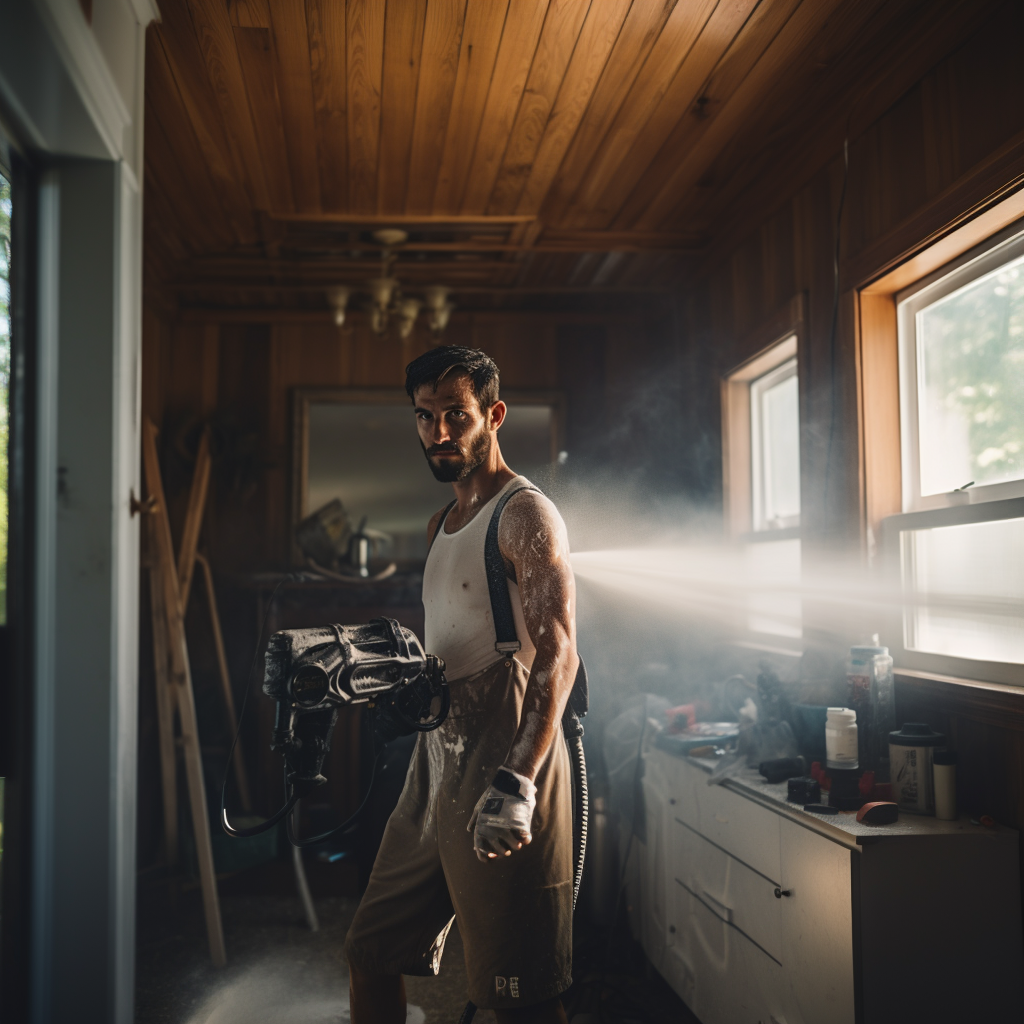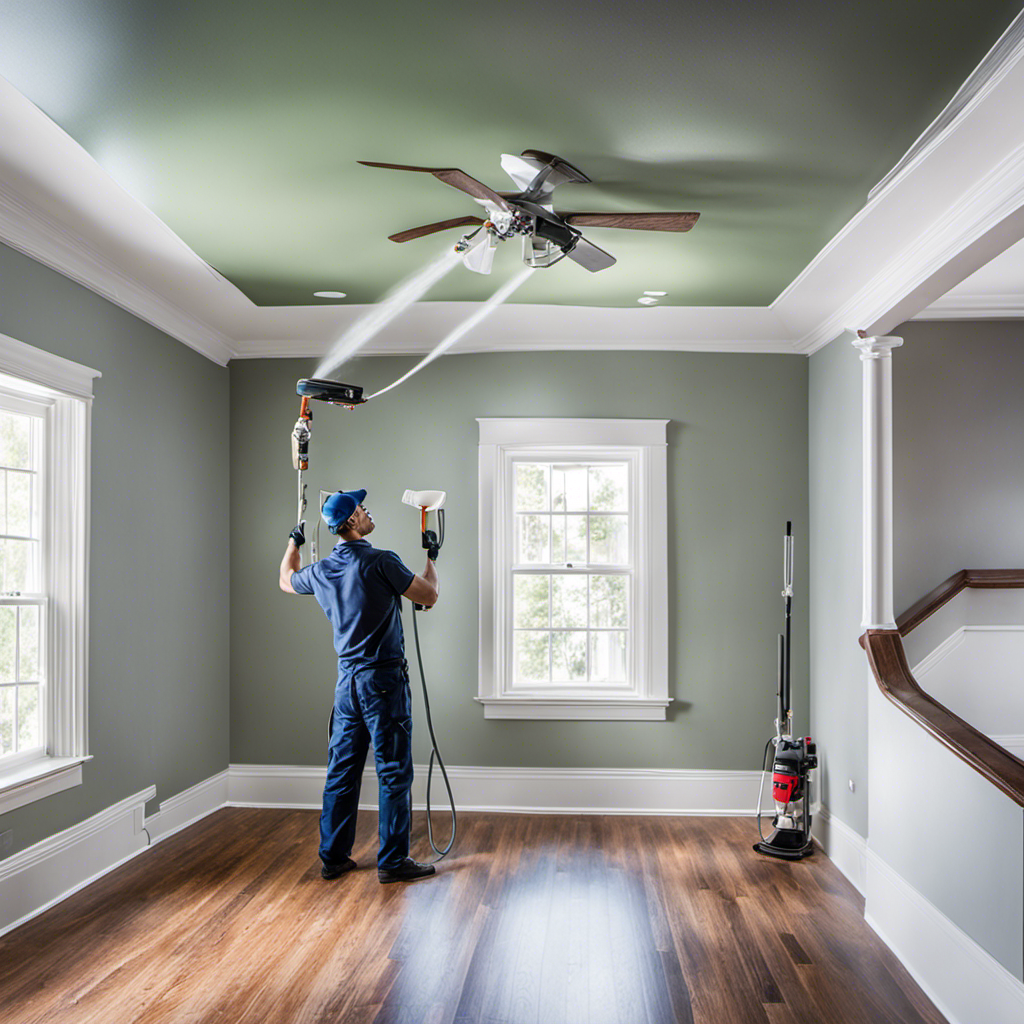To paint a room with two colors using a sprayer, start by choosing your primary and accent shades, planning where each will go for a balanced look. Protect your furniture and floor, then use painter’s tape on edges for sharp lines. Spray the main color evenly, then mask off the area for the second hue. Carefully switch colors, maintaining steady movement to avoid drips and guarantee crisp shifts. Keep practicing these techniques, and you’ll master a stunning double-tone finish.
Key Takeaways
- Plan your color scheme and use painter’s tape to create crisp, clean edges for the accent wall.
- Prepare surfaces and protect furniture with drop cloths before starting to paint.
- Use a sprayer at a consistent distance (around 12 inches) for smooth, even coverage.
- Spray the primary color first, then carefully mask and spray the accent wall with a contrasting hue.
- Remove the tape once paint is dry to reveal sharp lines and a professional two-tone finish.

Painting a room with two colors can dramatically enhance its look and create a stylish, personalized space. When you decide to use a sprayer for this project, it becomes even easier to achieve clean lines and seamless progressions between the two shades. To start, plan your color coordination carefully. Choose a primary color for the larger areas and a contrasting or complementary hue for the accent wall. Think about how the colors will interact and how you want the space to feel—calm, energetic, sophisticated? Once you’ve settled on your palette, move on to prepping the room. Cover furniture and floors with drop cloths, tape off trim, and ensure the surfaces are clean and smooth.
Using a sprayer can give you smooth, even coverage, but mastering brush techniques is still essential for detail work and edges. For the accent wall, you’ll want to start with the primary color, applying it evenly across the walls with your sprayer. Keep the spray at a consistent distance and move steadily to avoid drips or uneven patches. Once the primary color is dry, it’s time to facilitate the transition to the accent shade. When you spray the border where the two colors meet, use painter’s tape to create a crisp line. Carefully tape along the transition edge, pressing down firmly to prevent overspray. When you’re ready to spray the accent wall, remove the tape as soon as the paint is dry enough to prevent peeling or smudging.
The key to clean, sharp lines with a sprayer lies in your spray technique. Keep the nozzle moving in smooth, overlapping strokes, and maintain a steady distance from the wall—usually about 12 inches. For more control, especially along the edges, you can use a smaller nozzle or switch to a brush for touch-ups. This gives you precision where the spray might be too broad or uneven. Remember, color coordination doesn’t just mean picking matching shades; it also involves how you apply them. Using the sprayer allows you to blend the transition subtly if desired, or keep it sharp with tape and careful technique. Additionally, understanding dog names can inspire creative naming for your project or decor themes. With patience and attention to detail, you’ll create a stunning two-tone room that looks professionally finished.
Frequently Asked Questions
What Type of Sprayer Is Best for Two-Tone Painting?
When choosing sprayer types for two-tone painting, you want one that offers control and precision. HVLP (High Volume Low Pressure) sprayers are ideal because they provide better control over paint consistency and minimize overspray, making them perfect for accent walls. Airless sprayers also work well for larger areas, but for detailed two-tone work, an HVLP sprayer gives you the finesse needed to achieve crisp lines and smooth finishes.
How Do I Prevent Paint Bleed Between Colors?
Imagine your wall as a canvas of vibrant hues; to keep the colors crisp and clean, you need sharp color separation. Use masking techniques like painter’s tape to create clear boundaries, preventing paint bleed. When spraying, hold the nozzle at the right distance and spray lightly along the edges. Carefully peel away the tape once dry, revealing sharp, distinct lines between your two colors.
Can I Use the Same Sprayer for Both Colors?
You can use the same sprayer for both colors, but you should clean it thoroughly between uses to prevent color mixing. Use brush techniques to spot-clean tricky areas, and consider rinsing the sprayer with water or paint thinner depending on your paint type. Proper paint mixing before starting guarantees consistent color. This way, you’ll get clean lines and avoid unwanted bleed, making your two-tone walls look sharp and professional.
What’s the Ideal Drying Time Between Coats?
When considering the drying time for paint application, you should typically wait 2-4 hours between coats, but always check the paint can for specific instructions. Factors like temperature and humidity can affect drying time. Rushing this process can lead to smudges or uneven color. To guarantee a smooth finish, give the paint enough time to dry thoroughly before applying the next coat, especially when working with two colors and a sprayer.
How Do I Clean the Sprayer After Painting?
A stitch in time saves nine, so start by cleaning your sprayer immediately after use. For the cleaning process, disassemble the sprayer, rinse all parts with warm water or solvent, and use a brush to remove paint residue. Proper sprayer maintenance guarantees it works smoothly next time. Don’t forget to dry all parts thoroughly before reassembling, keeping your equipment in top shape and ready for your next project.
Conclusion
Painting a room with two colors using a sprayer is a simple way to create a stylish accent wall. Remember, about 60% of homeowners find that adding an accent wall boosts their room’s appeal instantly. By carefully taping and spraying, you’ll achieve a clean, professional look in no time. With a little practice, you’ll enjoy a fresh, personalized space that reflects your style—making your home feel more vibrant and inviting.
Franz came aboard the Paint Sprayer Zone team with a background in both journalism and home renovation. His articulate writing style, combined with a passion for DIY projects, makes him an invaluable asset. Franz has a knack for breaking down technical jargon into easy-to-understand content, ensuring that even the most novice of readers can grasp the complexities of paint sprayers.










